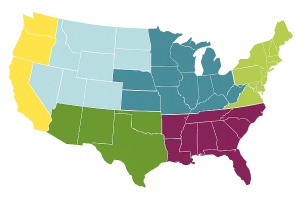New Hampshire Native Plants, State Flower & State Bird
Posted By American Meadows Content Team on Sep 27, 2012 · Revised on Oct 26, 2025

Knowing your location helps us recommend plants that will thrive in your climate, based on your Growing Zone.
Posted By American Meadows Content Team on Sep 27, 2012 · Revised on Oct 26, 2025
Native plants are adaptable, low-maintenance, and beautiful. They are the best choice for habitat-friendly gardens and thriving ecosystems. Find top picks for native plants in your state - and learn about your state bird and state flowers!
Follow Along With More Of Our Guides
Hello native plant enthusiasts! In the list below, you will find popular native plants and wildflower seeds, available from American Meadows, that have a native distribution in your state. You’ll also find information about your state bird, state flower, and state wildflower!
Grow our Native Northeast Wildflower Seed Mix
Showy Goldenrod (Solidago speciosa)
Wrinkleleaf Goldenrod (Solidago rugosa)
Perennial Lupine (Lupinus perennis)
Black Eyed Susan or Gloriosa Daisy (Rudbeckia hirta)
Butterfly Weed (Asclepias tuberosa)
Swamp Milkweed (Asclepias incarnata)
Common Milkweed (Asclepias syriaca)
White Trillium (Trillium grandiflorum)
Red Trillium (Trillium erectum)
Painted Trillium (Trillium undulatum)
Long Beaked Sedge (Carex sprengelii)
White Tinged Sedge (Carex albicans)
Appalachian Sedge (Carex appalachia)
Firewheel (Gaillardia pulchella)
Blanket Flower (Gaillardia aristata)
Lanceleaf Coreopsis (Coreopsis lanceolata)
Wild Bergamot (Monarda fistulosa)
Wild Geranium (Geranium maculatum)
Elderberry (Sambucus canadensis)
Phlox subulata (Creeping Phlox)
Obedient Plant (Physostegia virginiana)
Red Cardinal Flower (Lobelia cardinalis)
Meadow Anemone (Anemone canadensis)
Anise Hyssop (Agastache foeniculum)
Bottlebrush Grass (Elymus hystrix)
Big Bluestem (Andropogon gerardii)
Little Bluestem (Schizachyrium scoparium)
Tufted Hair Grass (Deschampsia cespitosa)
Yellow Prairie Grass (Sorghastrum nutans)
Wild Strawberry (Fragaria virginiana)
Lowbush Blueberry (Vaccinium angustifolium)
Smooth Blue Aster (Symphyotrichum laeve)
New England Aster (Symphyotrichum novae-angliae)
Common White Yarrow (Achillea millefolium)
Heliopsis (Heliopsis helianthoides)

Purple Finch ~ Carpodacus purpureus
Not purple at all, the male Purple Finch looks like a large-billed sparrow with a glowing red head. The brownish female is boldly streaked and wears white facial stripes. These small, conical-billed birds are usually most abundant at New England feeding stations in spring, when the red maples are in bloom. The writer Thoreau, who scattered crumbs for these birds at Walden Pond, loved to hear the Purple Finch's rich strains of music and their sharp call note. "The hearing of this note," he wrote, "implies great improvement in the acoustics of the air."
Lilac ~ Syringa vulgaris
If sentiment alone determined the most popular flowering shrub, it might well be the Lilac. There is hardly a person whose memory is not stirred by it, and its scent is one of the most familiar of all perfumes associated with flowers. Lilac flowers grow in panicles, or pyramid-shaped clusters. The panicles grow at the end of the small branches of a shrub or small tree which may reach twenty feet in height. In the spring, Lilac bushes are laden with fragrant clusters of flowers. They prefer rich soil but are strong enough to survive almost anywhere.
From The Wildflowers of the 50 States U.S. stamps issued July 24, 1992:

